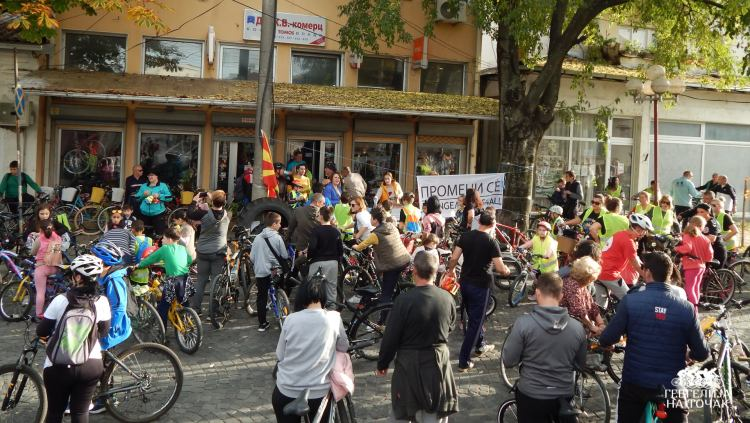Interview with Prof. Dejan Mirakovski, PhD, rector at University Goce Delchev in Shtip

When air pollution is high, most common recommendations are to stay indoors, but experts warn – this is not always good.
Once the weather situation improves, most of us forget about the polluted air in the heating season. But, this is not the case for the team of renowned experts in the field, and professors at University Goce Delchev in Shtip, who will work this summer to procure and assemble instruments to measure the air quality in schools and kindergartens in five municipalities. The measurements will begin in September in the following municipalities: Strumica, Struga, Gostivar, Kumanovo and Kavadarci.
One of the main recommendations on bad air quality day is “stay home/indoors” and “don’t expose to outdoor conditions for extended period of time”. But how much cleaner is the air at home than outside?
Depending of the type of pollution sources and indoor activities, as well as their construction characteristics, indoor air can often be significantly more polluted than outdoor air. Even during episodes of high outdoor pollution. Several studies around the world indicate that there are significant sources of pollution in our homes, exposure levels and negative effects on human health are higher indoors than outdoors. Our study in Lisiche settlement (Skopje) during 2021 showed similar results, and in that study homes that use old solid fuel heating and cooking devices were one of the target groups., During 24-hour measurement period, average concentrations of PM 2,5 suspended particles in homes heated with indoor solid fuel devices, ranged from 200,1 ± 123,1 µg/m3. For the same measuring period, the recorded average concentrations of outdoor PM 2,5 ranged from 53,57 ± 28,16 µg/m3. The obtained data clearly indicate significantly (almost 4 times) higher concentrations of suspended particles in homes, as compared to the outdoor conditions. This indicates a significantly different problem than our usual perception, because especially in the winter period, we spend more time indoors and in closed rooms than outside. Unfortunately, this is particularly in relation with sensitive categories such are children and the elderly, who are more sensitive to the negative effects of air pollution.

Children spend most of the day in educational institutions. What affects the air quality in a kindergarten/school?
The air quality in classrooms and rooms for children’s stay has caused great scientific interest in the recent period, primarily due to the fact that in addition to the negative impact on children’s health, it also has a significant impact to the efficiency and success of the educational process as a whole. The main determined problems from previous research are generally related to increased concentrations of chemical and/or biological hazards, as well as premises’ poor thermal comfort. The most common pollutants that occur in classrooms include increased concentrations of suspended particles as a result of their creation in the premises, or penetration from the external environment and constant re-suspension due to children’s activities. No less important are the increased concentrations of gaseous pollutants, such as formaldehyde or volatile organic compounds (VOCs). They are emitted from some types of floors, furniture, various devices and toys, printed materials, etc., and their increased concentrations can have significant negative effects on children’s health. Inadequate ventilation leads to disturbance of thermal comfort and increased concentrations of CO2, which can have negative effects on mental concentration and learning outcomes. Poor ventilation has also negative effect over the presence of increased concentrations of bio-aerosols (bacteria, viruses, spores and mold). This problem was especially frequent during the pandemic period. However, there are several challenges, and their solution is possible only if the conditions and concentrations of polluting substances are fully analyzed, as well as the reasons for their occurrence, which is actually the main goal of our latest research.
The kindergartens and schools in which the measurements will be made are yet to be selected in cooperation with the respective institutions and municipalities. Would you please explain how the measurements will be made?
The measurements methodology is defined in accordance with the recommendations of the World Health Organization (WHO) and the local specifics for air quality. These measurements include analysis of:
– the concentrations of suspended particles (chemical composition, mass, and concentration number of different fractions),
– the concentration of bioaerosols (total number),
– the concentration of gaseous pollutants such as CO2, CO, organic volatile components, and formaldehyde (trends and average concentrations), as well as
– analysis of ventilation parameters and thermal comfort in the rooms.
The measurement and sampling programs at each institution shall cover a period of at least one week and shall include measurements taken before, during and after school hours (Monday to Friday, from morning ‘till the end of the school day). Due to different emission and ventilation rates during the cold (November to March) and warm (May to September) periods, two monitoring or sampling campaigns will be performed to determine seasonal fluctuations in concentrations of certain pollutants. At least three sampling places will be selected in each institution, that will be representative for the buildings and will be selected after an initial assessment and in agreement with respective stakeholders. Factors affecting indoor air quality (indoor and outdoor combustion, types of furniture, equipment, etc.) will also be documented and reported. In addition, external environment will be analyzed, including proximity to roads, industrial sources of pollution, etc. The time of the beginning and end of the classes in which students are present, as well as the duration of (school) breaks will be documented. Appropriate quality control procedures will be established at all stages of measurement implementation, including calibration for accuracy testing, as well as ensuring full external monitoring of the calibration processes of all measuring devices included in the measurement programs.

When the first results should be expected?
According to the plans, during the summer we will work on operational procedures and on assembling, testing and calibrating the equipment. The first field measurements will begin in mid-September, and the field measurements are expected to be completed by March next year, so that the full results will be ready during May or June 2024. According to the plan, the entire study will be presented in September next year.




